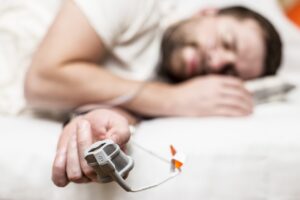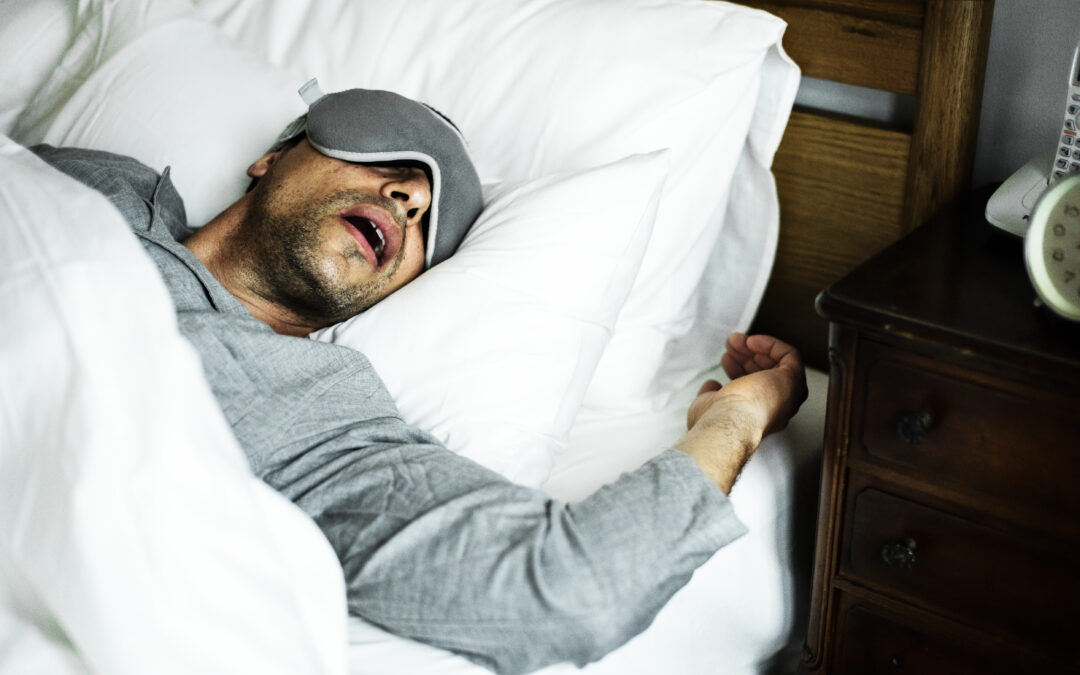Sleep apnea is one of the most common sleep issues that Americans face.
While it doesn’t at first sound deadly, it can cause, and be caused by, many more serious issues, which can present issues for your health. But what is sleep apnea? And how might it be affecting you?
We’ll go over what sleep apnea is, along with why it happens, what you can do to figure out if you have it, and what you can do to stop it.
What Is Sleep Apnea?
Sleep apnea is a condition where breathing during sleep is repeatedly stopped and started again. At first glance that doesn’t sound so bad. Breathing stops, then starts. So what’s the big issue with sleep apnea?
When you stops breathing during, even for a moment or two, the brain is awakened slightly to a lighter stage of sleep, which prevents the deepest, most restful aspects of sleep from continuing. These micro awakenings disrupt your typical sleep pattern, creating a much lower quality of sleep and leaving you feeling tired the next day, despite seeming like you had a full night’s rest. Repeated, untreated sleep apnea ends up seriously damaging your brain and body by disrupting this normal sleep pattern, as well as depriving the person of oxygen while they sleep.
This disruption in breathing can vary between person to person. People with sleep apnea tend to range widely in how often they stop breathing, varying from about five times an hour to up to 100 or more times an hour, with each pause in breathing lasting up to a minute at a time.

Some common symptoms of sleep apnea are:
- Loud snoring
- Gasping for air during sleep
- Morning headache
- Irritability after waking up
- Awakening with a dry mouth
- Excessive daytime sleepiness (hypersomnia)
- Difficulty staying asleep (insomnia)
- Difficulty paying attention while awake
Why Does Sleep Apnea Happen?
Sleep apnea happens for a number of reasons, and there’s different names for each type of sleep apnea.
Obstructive sleep apnea (OSA) is the most common type and is caused by a blockage of the airway during sleep. In obstructive sleep apnea, your throat muscles relax, and your tongue and soft palate collapse against the back of your throat while you’re asleep. When your muscles relax, your airway narrows or closes when you breathe in. This causes you to not get enough air, which can create lower oxygen levels in your blood. When your brain senses your inability to breathe, it briefly rouses you from sleep to help you reopen the airway. This awakening is usually so brief that you don’t remember it.
Central sleep apnea (CSA) is a less common type of sleep apnea. This is caused when the brain fails to send the correct signals to the muscles that control breathing during sleep. This means that your body makes no actual effort to breathe for a short period of time. You might wake up with shortness of breath, or have a difficult time either getting to sleep or staying asleep. There is no airway blockage in CSA, which makes it completely a neurological issue.
There’s also mixed sleep apnea (AKA Complex sleep apnea syndrome), which is a combination of both OSA and CSA.

OSA is the most common form of sleep apnea because the number of ways it can come about. It’s mechanical, as opposed to CSA’s more technical and specific cause. There’s a number of reasons why your throat might become more constricted during sleep, and a big contender is weight gain. It’s easy to pick up pounds that can contribute to a condition such as sleep apnea.
Excess weight creates fat deposits in a person’s neck, which is called pharyngeal fat. Pharyngeal fat can block your upper airway when you’re sleeping, which is when the airway is already relaxed. This is why snoring is one of the most common symptoms of sleep apnea; air is literally being pushed through a restricted airway, which causes a loud noise. Additionally, increased abdominal girth due to excess fat deposits have been shown to compress a person’s chest wall enough to decrease lung volume. This lack of lung volume causes less oxygen to get into our blood and less carbon dioxide to get out of our bodies. As well, there’s a link between losing sleep and weight gain. It becomes easier to stop doing healthy habits, and that lack of sleep can create chaos for your metabolism.
Less common causes of OSA include enlarged tonsils that can block the airway, anatomical features such as a naturally large neck or narrow throat, endocrine disorders (such as diabetes and thyroid disease), acid reflux, lung diseases, smoking, drinking, and heart problems. Men also tend to present with OSA 2-3 times more than women. However, roughly 60–90% of adults with OSA are overweight, which means that weight plays a huge contender in whether you’ll present with OSA.
So what’s the solution for sleep apnea?
It’s always best to go to a doctor to both diagnose your condition and provide the best insight into why you’re presenting with sleep apnea, along with the best treatment plan for it. That being said, if you’re both obese and presenting with OSA, one great benefit can be lifestyle and behavioral changes that help result in weight reduction. It’s proven that weight loss has shrunken fat deposits around the neck area, which has led to improved airflow during sleep.
It’s also found that OSO and weight loss have a joined relationship. When you lose weight, your OSA symptoms tend to lessen, meaning that you’re more active and able to lose more weight. This positive feedback loop is great, since people looking to eliminate OSA from their lives completely tend to have to just focus on weight loss, which will become easier as they lose weight.
There’s also links to loss of appetite as your OSA symptoms lessen. In one study, ghrelin (a hormone that stimulates appetite) levels were higher in OSA patients than in those without OSA who had the same body mass. These levels fell to comparable levels after two days of using CPAP treatment, a type of OSA treatment that typically uses a machine to help provide greater airflow to your lungs.
Early intervention is important with any form of sleep apnea. Going to a doctor and being tested for all types of sleep apnea is crucial to being able to best beat it.

